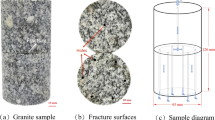Abstract
Compression shear failure of rock is a common failure mode in engineering, and there are often complicated seepage phenomena in its shear crack. Due to the anisotropic and irregular rough cross-section on both sides of the natural crack, the experimental study of rock seepage is difficult to operate. In order to study the microscopic seepage characteristics of rock cracks, granite crack specimens were prepared through shear experiments. The data was obtained by scanning the section with laser and imported into MATLAB software to reconstruct the three-dimensional section and crack opening model. In view of the difficulty of observing the microscopic characteristics of rock seepage flow, in this paper, the Reynolds equation of rock fracture flow considering the dynamic effect of boundary is derived, and under the condition of the definition of Reynolds equation theory, based on the advantage of fractal geometry for irregular cross-section, the relationship between flow velocity, permeability and simulation scale is studied by using COMSOL simulation software. The results show that the granite cross-section has a good statistical self-similarity feature, and the fractal matrix mesh covering the fracture surface can well express the feature of the fracture surface; The roughness of the fracture surface has a positive correlation with the fractal dimension. The larger the fractal dimension, the greater the roughness of the fracture surface, which verifies the reliability of the fractal dimension to describe the roughness of the section. There is a positive correlation between the scale-up of the simulation and the velocity of the micro-research points, and the permeability of the model; The feasibility of the fractal percolation model is investigated and the general suggestions for simulating scale are given. Some of the results of this study can be used for reference in the analysis of seepage characteristics of fractures in rough rock mass.














Similar content being viewed by others
References
Bandis S, Lumsden AC, Barton N (1981) Experimental studies of scale effects on the shear behavior of rock joints[J]. Int J Rock Mech Min Sci Geomech Abstr 18(1):1–21
Barton N (1976) The shear strength of rock and rock joints[J]. Int J Rock Mech Min Sci Geomech Abstr 13(9):255–279
Barton N, Bandis S. Effects of block size on the shear behavior of jointed rock[C]. Proceedings of the 23rd US Symposium on Rock Mechanics. Rotterdam: A. A. Balkema, 1982: 739–760.
Barton N, Choubey V (1977) The shear strength of rock joints in theory and practice[J]. Rock Mech 10(1/2):1–54
Barton N, Bandis S, Bakhtar K (1985) Strength, deformation and conductivity coupling of rock joints[J]. Int J Rock Mech Min Sci Geomech Abstr 22(3):121–140
He YL, Tao YJ, Yang LZ (2010) Experimental research on hydraulic behaviors in a single joint with various values of JRC[J]. Chin J Rock Mech Eng 29(1):3235–3241
Hongquan S (2006) Matlab program of fractal interpolation surface[J]. J Suzhou Univ Sci Technol 19(4):18–21
Hongquan S, Heping X (2008) Fractal simulation of rock fracture surface[J]. Rock Soil Mech 29(2):347–352
Huang RQ (2008) Geodynamical process and stability control of high rock slope development[J]. Chin J Rock Mech Eng 27(8):1525–1544
Ju Y, Zhang QG, Yang YM et al (2013) An experimental investigation on the mechanism of fluid flow through single rough fracture of rock. Sci China Tech Sci 56:2070–2080
Koyama T, Fardin N (2006) Numerical simulation of shear-induced flow anisotropy and scale-dependent aperture and transmissivity evolution of rock fracture replicas[J]. Int J Rock Mech Min Sci 43:89–106
Olsson R, Barton N (2001) An improved model for hydromelchanical coupling during shearing of rock joints[J]. Int J Rock Mech Min Sci 38(3):317–329
Qian J, Chen Z, Zhan H et al (2011) Experimental study of the effect of roughness and Reynolds number on fluid flow in rough-walled single fractures: a check of local cubic law. Hydrol Process 25:614–622
Shouju L, Yingxi L, Wenwen F, Chenfang H (2009) Randomly numerical simulation of water flow field in fractured rock mass with finite element method[J]. Rock Soil Mech 30(7): 2119–2125
Sisavath S, AL-Yaarubi A, Pain CC et al (2003) A simple model for deviations from the cubic law for a fracture undergoing dilation or closure[J]. Pure Appl Geophys 160(5–6):1009–1022
Tang SH, Zhu BC, Yan ZF (2011) Effect of crustal stress on hydraulic fracturing in coal bed methane wells[J]. J China Coal Soc 36(1):65–69
Xu RN, Jiang PX (2008) Numerical simulation of fluid flow in microporous media[J]. Int J Heat Fluid Flow 29(5):1447–1455
Zhou HW, Xie HP (2003) Direct estimation of the fractal dimension sofa fracture surface of rock[J]. Surf Rev Lett 10(5):751–762
Zimmerman RW, Bodvarsson GS (1996) Hydraulic conductivity of rock fractures[J]. Transp Porous Media 23(1):1–30
Acknowledgements
This work was supported in part by the State Key Laboratory of Deep Geomechanics and UndergroundEngineering and School of Mechanics and Civil Engineering(China University of Mining and Technology, Beijing), Higher educational scientific research projects of Inner Mongolia Autonomous Region(No.NJZY21291).We also express our thanks to the reviewers for their time andeffort on reviewing this paper.
Author information
Authors and Affiliations
Corresponding author
Additional information
Publisher's Note
Springer Nature remains neutral with regard to jurisdictional claims in published maps and institutional affiliations.
Rights and permissions
About this article
Cite this article
Yang, X., Zhang, W., Xue, D. et al. Seepage Analysis of Orthogonal Shear Cracks in Granite Based on Fractal Theory. Geotech Geol Eng 40, 425–441 (2022). https://doi.org/10.1007/s10706-021-01906-9
Received:
Accepted:
Published:
Issue Date:
DOI: https://doi.org/10.1007/s10706-021-01906-9




